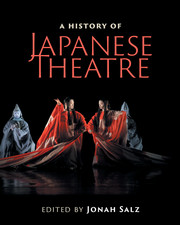Book contents
- Frontmatter
- Contents
- List of figures
- List of tables
- Contributors
- Contributors’ biographies
- Foreword
- Acknowledgments
- Note on Japanese terms
- List of abbreviations
- Timeline
- Editor's introduction
- I Traditional theatres
- Preface to Part I Japanese civilization arises
- II Modern theatres
- Preface to Part II
- 6 Birth of modern theatre: shimpa and shingeki
- Interlude Modern comedies and early musicals
- Interlude Takarazuka: all-girls’ revue and musicals
- 7 Rise of shingeki: Western-style theatre
- Interlude Manzai and Yoshimoto vaudeville comedy
- 8 Wartime colonial and traditional theatre
- Interlude Kami-shibai: picture-card storytelling
- 9 Maturing shingeki theatre
- Interlude Postwar musicals and commercial theatre
- 10 Sixties Theatre
- Interlude Butoh: dance of darkness and light
- 11 Contemporary theatre
- Interlude Tokyo: world theatre capital
- Interlude Charting Tokyo theatre today: 24 November 2012
- Interlude Modern theatre tomorrow: interview with Oriza Hirata
- III Arcs and patterns
- IV Theatre architecture
- Preface to Part IV Evolution of Japanese theatre architecture
- V Theatre criticism
- VI Intercultural influences
- Epilogue: Frozen words and mythology
- Further reading
- Index
- References
Interlude Butoh: dance of darkness and light
from Preface to Part II
Published online by Cambridge University Press: 05 July 2016
- Frontmatter
- Contents
- List of figures
- List of tables
- Contributors
- Contributors’ biographies
- Foreword
- Acknowledgments
- Note on Japanese terms
- List of abbreviations
- Timeline
- Editor's introduction
- I Traditional theatres
- Preface to Part I Japanese civilization arises
- II Modern theatres
- Preface to Part II
- 6 Birth of modern theatre: shimpa and shingeki
- Interlude Modern comedies and early musicals
- Interlude Takarazuka: all-girls’ revue and musicals
- 7 Rise of shingeki: Western-style theatre
- Interlude Manzai and Yoshimoto vaudeville comedy
- 8 Wartime colonial and traditional theatre
- Interlude Kami-shibai: picture-card storytelling
- 9 Maturing shingeki theatre
- Interlude Postwar musicals and commercial theatre
- 10 Sixties Theatre
- Interlude Butoh: dance of darkness and light
- 11 Contemporary theatre
- Interlude Tokyo: world theatre capital
- Interlude Charting Tokyo theatre today: 24 November 2012
- Interlude Modern theatre tomorrow: interview with Oriza Hirata
- III Arcs and patterns
- IV Theatre architecture
- Preface to Part IV Evolution of Japanese theatre architecture
- V Theatre criticism
- VI Intercultural influences
- Epilogue: Frozen words and mythology
- Further reading
- Index
- References
Summary
Butoh is a dance or performance genre originating in Tokyo in the postwar era, primarily through the activities of Hijikata Tatsumi (1928–86; Figure 43). Butoh dances often feature near-naked dancers in white-face and body paint, with slow, precise, contorted movements either entirely improvised or highly choreographed. Butoh artists have often sought to plumb the depths of humanity or to provide a privileged aperture to timeless truths. Defining butoh must remain tentative: because of its acceptance as both theatre and contemporary dance, and rapid global expansion, butoh continues to embrace and elaborate a wide spectrum of methods and themes.
Hijikata's non-dance experiments
Founder Hijikata trained in ballet, jazz, tap, flamenco, and German Expressionist dance before breaking from those traditions. His first piece, Kinjiki (Forbidden colors, 1959), depicted a man having sex with a younger man, then forcing him to kill a chicken – a performance ostensibly based on the novel by Mishima Yukio (1925–70) and writings of Jean Genet (1910–86). Hijikata, however, quickly turned away from such mimetic dance. For the next decade, he led a small cohort of dancers and visual artists from the spheres of neo-Dadaism and Happenings to experiment with widening the scope of dance to include activities such as eating cake, running wind-sprints, and photographing the audience. In addition, performers staged taboo subjects and extreme states of being such as disease, madness, senility, violence, and pain.
In the late 1960s and early 1970s, Hijikata began an exhaustive and detailed examination of ways that his body-mind had been formed and socialized, at the same time an experiment in achieving a radically new generative body-mind. This experiment was based on the double assumption that he could mine his own past for new dance movements, and that such minute awareness would allow him to break free of previously unconscious physical and mental strictures. Concurrently, he turned to detailed, structured choreography in which dancers performed a movement or pose while visualizing various images to affect the qualities of their movements. Common visualizations included altering the character imagined to be doing the movement: an old person character's movements more stooped and slower than a young person's. Dancers also were instructed to alter the imagined context, to interpret doing movements in water or glass.
- Type
- Chapter
- Information
- A History of Japanese Theatre , pp. 321 - 325Publisher: Cambridge University PressPrint publication year: 2016

